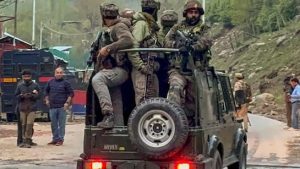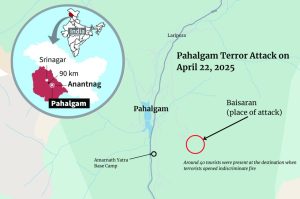The Kashmir Terror Attack 2025 in Pahalgam left 26 dead, including three from West Bengal. Discover how this tragedy shattered Bengal’s deep cultural connection to Kashmir and raised urgent questions about tourism safety and communal harmony.
On April 22, 2025, the serene landscapes of Pahalgam in Jammu and Kashmir were marred by a heinous terrorist attack that claimed the lives of 26 tourists and injured over 20 others. This incident not only shook the nation but also reignited discussions on security, communal harmony, and the geopolitical dynamics of the region.
Recently, a significant number of Bengali tourists—who typically limit their summer travel to Darjeeling and Sikkim—have been visiting Kashmir, frequently motivated by social media posts. Those who were present just days earlier were shocked by the Pahalgam killings, which many saw as a near escape. However, these travellers feel sorry for the lay Kashmiris who will be severely hurt if tourism is affected by the deaths, in contrast to those who have never visited Kashmir and are writing angry posts criticising its people and their faith.
West Bengal mourns the loss of three of its residents. Among the victims was Bitan Adhikary, a 40-year-old US-based IT professional from Kolkata, who was vacationing with his family. His wife and young son survived the attack. Manish was an Intelligence Bureau officer posted in Hyderabad. Sameer was a Central government employee. The state government has extended support to the bereaved families and is coordinating efforts to bring them back home. This tragic incident has deeply affected the people of West Bengal, a state with a longstanding cultural and emotional connection to Kashmir. The loss of its residents in such a heinous act of violence underscores the urgent need for enhanced security measures and communal harmony to prevent future tragedies.
The attack occurred in the Baisaran Valley near Pahalgam, a popular tourist destination known for its picturesque meadows and tranquil environment. Five militants, armed with AK-47s and M4 carbines, targeted tourists, specifically focusing on Hindu visitors. Eyewitnesses reported that the assailants asked victims to state their names and religions before opening fire. Some were even asked to recite the Islamic kalima to determine their faith. The brutality of the attack was evident, with reports indicating that men were forced to remove their trousers to check for circumcision, a method used to identify non-Muslims.
Casualties
Among the 26 fatalities were 23 Indian nationals from various states, including West Bengal, Maharashtra, and Uttar Pradesh. Notably, Lt. Vinay Narwal, a 26-year-old Navy officer from Haryana, was among the deceased. He was on his honeymoon, having married just days prior.

Bengal’s Deep Connection to Kashmir Tourism
Over the decades, West Bengal has cultivated a unique emotional and cultural bond with Kashmir. For thousands of Bengali families, especially from Kolkata and surrounding districts, Kashmir is more than a travel destination—it’s a cherished dream, often referred to as “heaven on Earth.” Whether it’s the snow-capped peaks of Gulmarg or the lush meadows of Pahalgam, Bengalis have flocked to the Valley in large numbers, especially during summer and Durga Puja holidays.
According to tourism industry estimates, 25% to 30% of Kashmir’s domestic tourists annually hail from West Bengal. This makes Bengali travelers one of the largest visitor demographics in the Valley. Local tour operators in both Srinagar and Kolkata have long nurtured this travel corridor through curated family packages, honeymoon itineraries, and senior citizen tours.
However, in the wake of the Pahalgam terror attack, there has been a visible and immediate drop in bookings from Bengal. Travel agencies in Kolkata reported a spike in cancellations within hours of the news breaking. Several prospective travelers have reportedly changed their plans, shifting to alternative destinations like Himachal Pradesh, Sikkim, or even the Andamans. A tour operator in New Market noted, “Kashmir was a top seller for us. But this attack has made many rethink their plans. Safety is now the biggest concern.”
The emotional impact on Bengali households has been profound. Many Bengalis identified with the victims not just geographically, but culturally. The tragic death of US-based techie Bitan Adhikary from Kolkata and the survival story of Professor Debashish Bhattacharya, a Bengali Brahmin academic, have resonated deeply with the public and the media in West Bengal.




The connection between Bengal and Kashmir has long been romanticized in literature, cinema, and art—from Rabindranath Tagore’s poetic musings on Himalayan beauty to Satyajit Ray’s references to Kashmir in popular Bengali culture. But this cultural warmth is now being shadowed by the cold winds of insecurity and political unrest.
In the long run, rebuilding confidence among Bengali tourists will require not just assurances from government authorities, but visible and sustained efforts toward peace, safety, and transparency in the Valley. Otherwise, the fear generated by this horrific incident could undermine one of the strongest cultural and economic bridges between the East and North of India.
Also Read : Pahalgam Terror Attack: 1 Prayer, 1 Miracle – How a Hindu Professor Escaped The Attack
Survivors’ Accounts
One of the most harrowing survivor stories is that of Professor Debashish Bhattacharya from Assam University. While on vacation with his family, he reportedly recited the kalima when confronted by the militants, a move that possibly saved their lives.
Perpetrators and Motive
The Resistance Front (TRF), an offshoot of the Pakistan-based Lashkar-e-Taiba, claimed responsibility for the attack. Intelligence agencies identified Saifullah Kasuri, also known as Khalid, a senior LeT commander, as the mastermind behind the massacre. The attackers aimed to oppose the alleged demographic changes in Kashmir, targeting non-local Hindus to instill fear and deter settlement in the region.
Government and Security Response
Immediate Actions
Prime Minister Narendra Modi condemned the attack, emphasizing the government’s unshakable resolve to combat terrorism. He assured that those responsible would face justice.
Investigations
The National Investigation Agency (NIA) initiated a probe, with the Jammu and Kashmir Police releasing sketches of the suspected militants. The attackers were identified as Asif Fauji, Suleman Shah, and Abu Talha, all linked to previous terror incidents in the Poonch region.
International Reactions and Diplomatic Fallout
The attack drew widespread condemnation from global leaders. India accused Pakistan of harboring terrorist groups, leading to a significant diplomatic rift. In response, India downgraded diplomatic ties, suspended the Indus Waters Treaty, and closed its main border crossing. Pakistan retaliated by freezing trade, canceling Indian visas, and restricting airspace.
Impact on Tourism and Local Economy
The attack severely impacted tourism in Kashmir, especially during the peak season. Tour operators in Kolkata reported mass cancellations, with many tourists removing Kashmir from their travel plans. The local economy, heavily reliant on tourism, faced substantial losses.
Also Read : US-Based Techie Killed in Kashmir Terror Attack During Family Vacation: 40-Year-Old Father’s Life Cut Short
Communal Harmony and Public Sentiment
Despite the communal targeting, stories like that of Professor Bhattacharya highlighted the importance of interfaith understanding. His knowledge of Islamic practices, which potentially saved his family, became a symbol of unity amidst adversity.


The Pahalgam terror attack stands as a grim reminder of the persistent threats posed by terrorism. While the nation mourns the loss of innocent lives, it also underscores the need for robust security measures, diplomatic vigilance, and the promotion of communal harmony to prevent such tragedies in the future.
Home Ministry & Security Boost
The Ministry of Home Affairs 🔗 mha.gov.in launched an emergency review of security arrangements across all tourist hotspots in Kashmir. Additional paramilitary forces were deployed in Pahalgam, Gulmarg, and Sonmarg.
The Jammu and Kashmir Police 🔗 jkpolice.gov.in released sketches and drone surveillance footage of the attackers and announced rewards for information on their whereabouts.
The National Investigation Agency (NIA) was brought in to lead the probe, and an inter-agency task force was created to track down the masterminds, especially those based in Pakistan.
Also read: Home | Channel 6 Network – Latest News, Breaking Updates: Politics, Business, Tech & More


